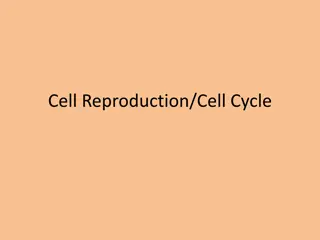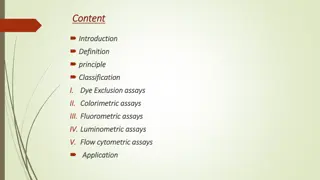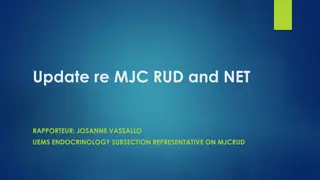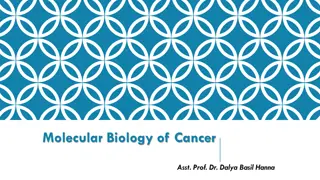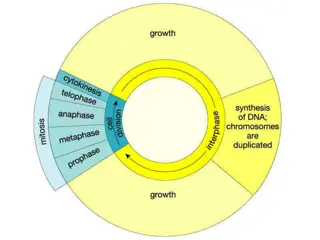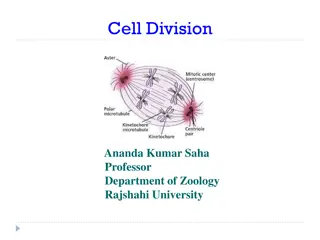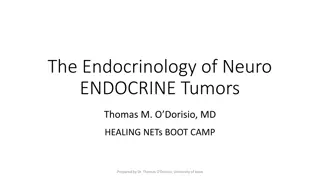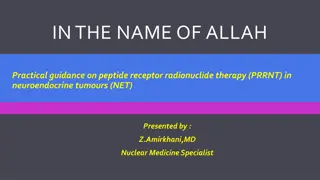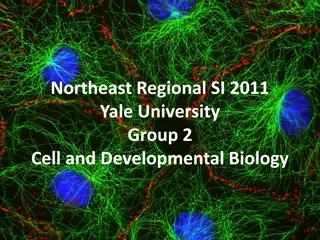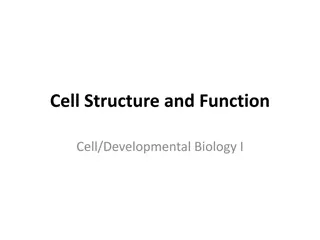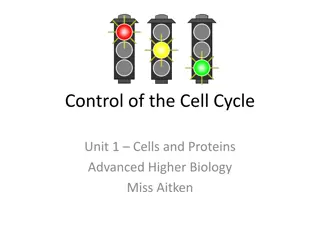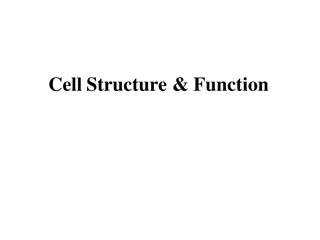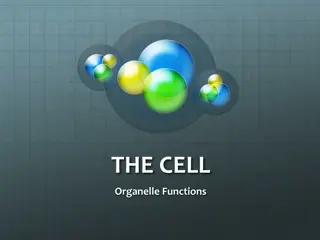Organoid Models for Neuroendocrine Cell Growth and Tumorigenesis
Research presented at the ENETS 2020 virtual meeting discussed the generation of organoids from lung, intestinal, and pancreatic neuroendocrine neoplasms (NENs) to study normal neuroendocrine cells and their transformation to NENs. The success rate in generating organoids was higher for lung NENs compared to intestinal or pancreatic NENs. The organoids expressed neuroendocrine markers, providing valuable insights for mechanistic and drug response studies in NENs.
Download Presentation

Please find below an Image/Link to download the presentation.
The content on the website is provided AS IS for your information and personal use only. It may not be sold, licensed, or shared on other websites without obtaining consent from the author.If you encounter any issues during the download, it is possible that the publisher has removed the file from their server.
You are allowed to download the files provided on this website for personal or commercial use, subject to the condition that they are used lawfully. All files are the property of their respective owners.
The content on the website is provided AS IS for your information and personal use only. It may not be sold, licensed, or shared on other websites without obtaining consent from the author.
E N D
Presentation Transcript
MEETING SUMMARY ENETS 2020 VIRTUAL MEETING Dr. Mauro Cives Assistant Professor University of Bari, Italy March 2020 2
DISCLAIMER AND DISCLOSURES NET CONNECT is supported by an Independent Educational Grant from Ipsen The views expressed within this presentation are the personal opinion of the author. They do not necessarily represent the views of the author s academic institution or the rest of the NET CONNECT group DISCLOSURES DR. CIVES Speaker fees from Ipsen and Novartis 3
PRESIDENTIAL ABSTRACT BASIC SCIENCE: ORGANOID MODELS OF NEUROENDOCRINE CELL GROWTH AND TUMORIGENESIS Dayton T, et al. ENETS 2020. Abstract #B01 4
BACKGROUND There are few models that can be used for mechanistic and drug response studies for neuroendocrine neoplasms (NENs) Advantages of organoids: Defined in vitro system Can be grown from both healthy and diseased tissues Recapitulate stem cell differentiation dynamics This research aimed to build a NEN biobank of pancreatic, intestinal and lung NECs and NETs To be used to study normal neuroendocrine cells and model their transformation to NENs Generating pulmonary neuroendocrine cell enriched human airway organoids for characterization and modelling of lung NENs NEC, neuroendocrine carcinomas; NET, neuroendocrine tumours Dayton T, et al. ENETS 2020. Abstract #B01 (oral presentation) 5
KEY RESULTS SUCCESS RATE IN GENERATING ORGANOIDS Lung NENs Intestinal NENs Pancreatic NENs 3 5 21 27 No growth In culture 26 20 Total = 23 87% 3 Total = 48 56% 0 Total = 31 16% 1 Success rate: # NEC: Success rate in generating organoids higher in lung NENs (87%) as compared with intestinal (56%) or pancreatic NENs (16%) IntNENs, intestinal neuroendocrine neoplasm; NEC, neuroendocrine carcinoma; NEN, neuroendocrine neoplasm; PaNENs, pancreatic neuroendocrine neoplasm Dayton T, et al. ENETS 2020. Abstract #B01 (oral presentation) 6
KEY RESULTS NEN ORGANOIDS EXPRESS NE MARKERS Lung NENs Intestinal NENs Pancreatic NENs Lung tissue 46T (LCNEC) Lung NET 13 Lung NET 17 EEC organoids intNEN 41 intNEN 43 Pancreas tissue pNEN 16 pNEN 20 (LCNEC) 200 600 400 10,250 Relative expression 5,250 300 150 250 15 150 100 10 100 50 5 50 0 0 0 CHGA NEUROD1 INSM1 CHGA NEUROD1 INSM1 CHGA NEUROD1 INSM1 CHGA, chromogranin A; EEC, enteroendocrine cell; INSM1, insulinoma-associated 1; IntNENs, intestinal neuroendocrine neoplasm; LCNEC, large cell neuroendocrine carcinoma; NE, neuroendocrine; NEN, neuroendocrine neoplasm; NEUROD1; neurogenic differentiation factor 1; NET, neuroendocrine tumours; PaNEN (pNEN), pancreatic neuroendocrine neoplasm Dayton T, et al. ENETS 2020. Abstract #B01 (oral presentation) 7
KEY RESULTS Media components critically influence NEN organoid growth Suggests potential therapeutic vulnerabilities NEN organoids maintain expression of neuroendocrine markers across multiple passages NEN organoids maintain the intratumour heterogeneity of the primary tumour NEN organoids allow phylogenetic dissection of tumour sub-clones Pulmonary neuroendocrine cell differentiation can be achieved in organoids NEN, neuroendocrine neoplasm Dayton T, et al. ENETS 2020. Abstract #B01 (oral presentation) 8
SUMMARY NEN organoids and PNEC-enriched fetal AOs are novel preclinical in vitro models for the study of NE biology and disease A collection of organoid cultures from NEN primary tumours and matched normal tissue has been established The expression of NE markers and the presence of the same genetic alterations identified in the primary tumour suggest that organoids may serve as a bona fide model of NENs PNECs are maintained long term over multiple passages and high numbers of differentiated PNEC can be achieved PNEC differentiation can be promoted by using a specific cocktail of small molecules AO, fetal airways organoid; NE, neuroendocrine; NEN, neuroendocrine neoplasm; PNEC, pulmonary neuroendocrine cell Dayton T, et al. ENETS 2020. Abstract #B01 (oral presentation) 9
MUTATIONAL LANDSCAPE OF 109 HIGH-GRADE GASTROENTEROPANCREATIC NEUROENDOCRINE NEOPLASMS G3 Venizelos AA, et al. ENETS 2020. Abstract #C20 10
BACKGROUND Gastroenteropancreatic (GEP) G3 NENs are rare with a poor outcome The genetic background of G3 NENs (NETs + NECs) has been poorly investigated to date The aim of this research was to gain tools for better prediction and to aid treatment decisions to improve survival in this patient population The genetic landscape of 109 high-grade GEP NEN patients (16 NET G3 and 93 NEC) was assessed from the Nordic Prospective Registry between 2013 2017 DNA from FFPE samples and matched blood samples was analysed All cases were re-assessed by a pathology expert NGS targeted sequencing using a pan-cancer panel was used DNA, deoxyribonucleic acid; FFPE, formalin-fixed paraffin-embedded; G3, grade 3; NEC, neuroendocrine carcinoma; NEN, neuroendocrine neoplasm; NET, neuroendocrine tumour; NGS, next generation sequencing Venizelos AA, et al. ENETS 2020. Abstract #C20 (oral presentation) 11
KEY RESULTS NEC NET G3 Frequently mutated genes Frequently mutated genes TP53 59% ATRX 19% APC 31% SF3B1 19% BRAF 24% MEN1 12% KRAS 24% Stratified by tumour site In remaining tumours (pancreatic, oesophageal, gastric) TP53 was mutated >50% Less frequently mutated genes included DICER, EGFR, FOXO1 and SOX9 Colon (n=31) TP53 68% BRAF 52% APC 42% Rectal (n=24) TP53 50% APC 50% KRAS 25% G3, grade 3; NEC, neuroendocrine carcinomas; NET, neuroendocrine tumours Venizelos AA, et al. ENETS 2020. Abstract #C20 (oral presentation) 12
SUMMARY NEC are altered in 87.1% of cases Most common mutations include TP53, APC, BRAF, and KRAS MSI detected in 9% of cases Colon NEC are enriched in mutations of BRAF NET G3 are altered in 68.75% of cases Most common mutations include ATRX, SFB1, MEN1 NET G3 and NEC have distinct genetic features This may pave the way to more personalized treatments in the future G3, grade 3; MSI, microsatellite instability; NEC, neuroendocrine carcinomas; NET, neuroendocrine tumours Venizelos AA, et al. ENETS 2020. Abstract #C20 (oral presentation) 13
INTERIM ANALYSIS OF PROSPECTIVE EVALUATION OF THE MANAGEMENT OF SPORADIC NON-FUNCTIONING ASYMPTOMATIC PANCREATIC NEUROENDOCRINE NEOPLASMS 2 CM (ASPEN STUDY) Partelli S, et al. ENETS 2020. Abstract #D40 14
BACKGROUND In the last decade a dramatic increase in diagnosis of small, incidentally discovered, NF-PanNENs was observed A relationship between the tumour diameter and low risk of malignancy and systemic progression has been noted a tumour size 2 cm seems to be associated with a negligible risk of disease recurrence and with a very low incidence of aggressive features such as lymph node involvement Guidance regarding most appropriate management of sporadic asymptomatic NF-PanNETs varies in current guidelines: ENETS: In patients with... p-NETs 2 cm or with NF-pNETs on imaging studies, routine surgical exploration continues not to be generally recommended. In patients with p-NETs>2 cm, enucleation at surgery remains the generally recommended surgical procedure NANETS: ...initial observation is an acceptable treatment strategy for asymptomatic patients with PanNET <1 cm ( ) it is recommended that decision to observe or resect an asymptomatic PanNET 1 to 2 cm in size be individualized Available data are based on retrospective studies with a significant heterogeneity of inclusion criteria and different tumour diameter cut-off and the appropriate management. The ASPEN study investigated most appropriate management prospectively ENETS, European Neuroendocrine Tumour Society; NANETS, North America Neuroendocrine Tumour Society; NF, non-functioning; PanNET, pancreatic neuroendocrine tumour Massironi S, et al. Oncotarget 2016;7:18978-83; Partelli S, et al. Br J Surg 2017;104:34-41; Howe J, et al. Pancreas 2020; 49: 1-33; FalconiM, et al. Neuroendocrinology 2016; 103: 153-71; PartelliS, et al. ENETS 2020. Abstract #D40 (oral presentation) 15
STUDY FLOW CHART Primary objectives: To evaluate the most appropriate management (active surveillance versus surgery) of sporadic asymptomatic NF-PanNET 2 cm Asymptomatic NF-PanNET 2 cm Diagnostic confirmation 68Ga PET or FNA+ Secondary objectives: To estimate the frequency of asymptomatic sporadic NF-PanNET 2 cm among overall sporadic NF-PanNET Inclusion at physician s discretion: To observe NF-PanNET evolution (development of symptoms, tumour growth, development of distant metastases) Active surveillance Surgery Prospective international multicenter cohort study Target enrolment: 1000 patients Study duration: 6 years (2017-2023) 43 centres involved, including 20 ENETS CoE To evaluate the perceived burden of surveillance or follow-up after surgery for participants CoE, centres of excellence; ENETS, European Neuroendocrine Tumor Society; FNA, fine needle aspiration; 68Ga, gallium-68; NF, non-functioning; PanNET, pancreatic neuroendocrine tumour; PET, positron emission tomography Partelli S, et al. ENETS 2020. Abstract #D40 (oral presentation); www.clinicaltrials.gov 16
KEY RESULTS RESULTS SURGICAL OUTCOMES Surveillance n=310 n (%) 65 (56-72) 12.9 (3.9) Surgery n=76 n (%) 58 (51-68) 14.5 (4.4) P N (%) Variable Resection type Pancreaticoduodenectomy Central pancreatomy Distal pancreatomy Enucleation Other Surgical approach Minimally invasive Laparotomy Complication grade No complication I II III IV 15 (19.7) 2 (2.6) 39 (51.3) 13 (17.1) 7 (9.2) Age, median (IQR) Diameter, mean (SD) Site lesion Head Uncinate process Body Tail MPD (mm), mean (SD) ECOG 0 1 2 Liver metastases Yes Ki67 mean (SD) <0.01 <0.01 83 (26.8) 36 (11.6) 107 (34.5) 84 (27.1) 2.4 (3.0) 15 (19.7) 7 (9.2) 22 (28.9) 32 (42.2) 4.3 (3.8) 0.08 46 (60.5) 30 (39.5) <0.01 52 (68.4) 8 (10.5) 7 (9.2) 5 (6.6) 4 (5.3) 268 (86.5) 34 (11.0) 7 (2.5) 71 (93.4) 5 (6.6) 0 (0.0) 0.45 0 2 (0.2) 2.4 1 1.4 0.01 Indications for surgery: Patient s preference: 46% Physician s preference: 35% Presence of dilation of the main pancreatic duct: 13% Increase in tumour size: 4% Presence of distant metastases: 3% ECOG, Eastern Cooperative Oncology Group; IQR, inter-quartile range; MPD, main pancreatic duct; SD, standard deviation Partelli S, et al. ENETS 2020. Abstract #D40 (oral presentation) 17
SUMMARY A large majority of patients with asymptomatic NF-PanNET 2 cm undergo active surveillance but a fraction undergo surgery despite guideline recommendations The risk of malignant behaviour for asymptomatic NF-PanNET 2 cm exists although very low The main indication for surgery is still related to patient s preference who cannot cope with a surveillance strategy Tumour size and patient s age influence physician s strategy We await the full results of the ASPEN trial NF, non-functioning; PanNET, pancreatic neuroendocrine tumour Partelli S, et al. ENETS 2020. Abstract #D40 (oral presentation) 18
REACH NET CONNECT VIA TWITTER, LINKEDIN, VIMEO & EMAIL OR VISIT THE GROUP S WEBSITE http://www.net-connect.info Follow the NET CONNECT group on LinkedIn Watch us on the Vimeo Channel NET CONNECT Email Follow us on Twitter @net-connectinfo antoine.lacombe @cor2ed.com 19
NET CONNECT Bodenackerstrasse 17 4103 Bottmingen SWITZERLAND Dr. Antoine Lacombe Pharm D, MBA Phone: +41 79 529 42 79 antoine.lacombe@cor2ed.com Dr. Froukje Sosef MD Phone: +31 6 2324 3636 froukje.sosef@cor2ed.com




